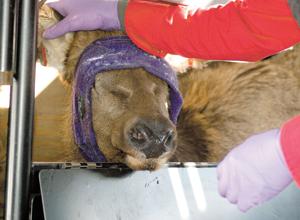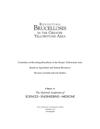https://www.google.com/url?rct=j&sa=t&url=http://www.jhnewsandguide.com/news/environmental/experts-shift-brucellosis-focus-from-bison-to-elk/article_5943ff30-7a99-570b-b801-546a85b76cd2.html&ct=ga&cd=CAEYACoTMjU5NzU0NzA2NzYyNDExMTYwOTIaZDU2MjY2MGY2ZDYzYjlmMTpjb206ZW46VVM&usg=AFQjCNGx3mwwEttcHwIh_L-G3dBDsTi43A
Experts: Shift brucellosis focus from bison to elk
Careful phase-out of feedgrounds could aid reduction of disease, panel says.
POSTED: WEDNESDAY, JUNE 7, 2017 4:30 AM
A committee of veterinarians and wildlife scientists is advising managers to turn their attention toward elk in the effort to reduce the transmission of brucellosis to cattle.
No silver bullet exists to eliminate the disease, though the Committee on Revisiting Brucellosis in the Greater Yellowstone Area recommends incrementally closing elk feedgrounds to help stem the spread of an expanding disease.
“The use of supplemental feedgrounds should be gradually reduced,” Washington State University professor Terry McElwain said in a May 31 presentation that aired online. “But it’s very important that this be done in a strategic, step-wise and science-based approach that should be undertaken by state and federal land managers.”
McElwain’s remarks were part of the unveiling of the first comprehensive study of brucellosis in the Yellowstone region since 1998. The National Academies of Sciences, Engineering and Medicine prepared the report at the request of the U.S. Department of Agriculture’s Animal and Plant Health Inspection Service office — the branch of the federal government that deals with livestock health threats and wildlife conflicts and disease.
An impetus for the agency’s interest is the disease’s continued spread.
Whereas brucellosis was confined to wild bison and feedground elk 19 years ago, it has since spread to elk throughout much of the ecosystem and, on 27 occasions, to domestic cattle and bison herds in Montana, Wyoming and Idaho.
McElwain called the growing prevalence among unfed elk herds and the re-emergence in captive animals a “cause for alarm.”
A bacteria-spread infectious disease, brucellosis can cause elk, cattle and other hosts to abort their firstborn offspring. Fetuses are in turn infectious and a vector for spread of the bacteria.
The treatable disease can be contracted by humans and has implications for livestock producers whose herds become infected. All individuals in Brucella abortus-positive herds must be tested repeatedly, and animals that test positive are slaughtered.
The committee’s report recommends “adaptively managing” for brucellosis, and making “data-based decisions” for reducing the risk of its spread from elk. Its advice to managers is to continue the separation of bison and cattle outside Yellowstone National Park.
Other recommendations are for state and federal agencies to collaborate and share data, and for the research community to fill in gaps in the science.
A decision to move away from feeding elk may result in increased transmission to cattle in the short-term, owing to increased unwanted mingling between the wild and domestic species, the report says.
“The weight of evidence nonetheless suggests that reduced use or incremental closure of feedgrounds could benefit elk health in the long-term,” McElwain and co-authors wrote, “and could reduce the overall prevalence of brucellosis in elk on a broad population basis.”
The committee’s 16-month review argued that brucellosis is a “complex” problem that will require “significant cooperation” among federal, state, tribal and private entities to fix.
“Brucellosis was eliminated from cattle in the United States after nearly a century of dedicated funding and resources from USDA, states, and livestock producers,” the study says. “With increasing incidence of brucellosis in cattle and domestic bison herds in the Greater Yellowstone Area in the past few decades due to transmission from elk, significant resources are needed to address a problem that is expanding in scale and scope.
“Without the changes and investments necessary to aggressively address this problem in a coordinated and cost-effective manner,” the researchers concluded, “brucellosis may spread beyond the Greater Yellowstone Area into other parts of the United States, resulting in serious economic and potential public health consequences.”
To see a copy of the Committee on Revisiting Brucellosis in the Greater Yellowstone Area report, go to the online version of this story at JHNewsAndGuide.com.












No comments:
Post a Comment